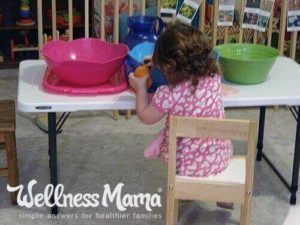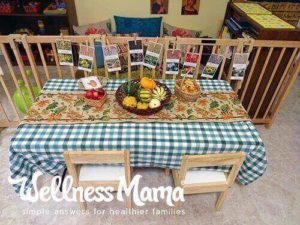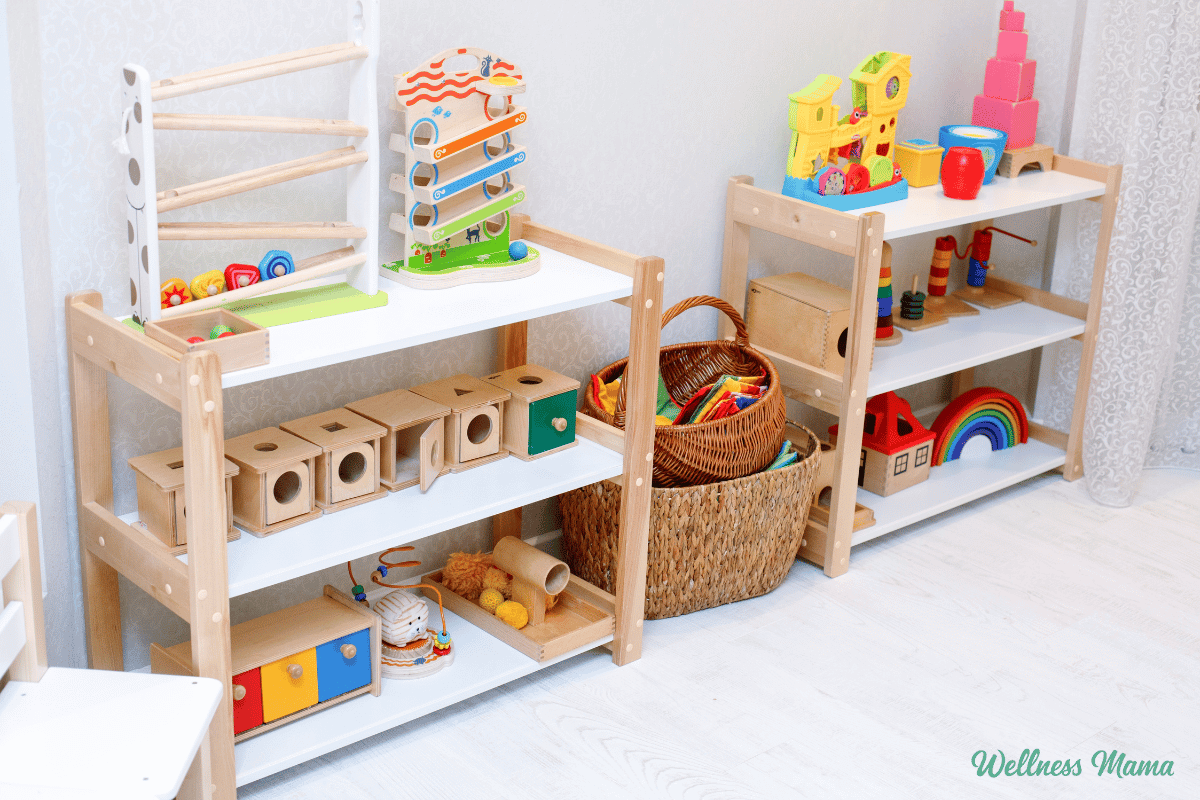While homeschooling looks a little different these days for our family, the Montessori approach still influences our home. Maybe you’re looking into a Montessori school or you just want to include some Montessori principles in your day. You can create a welcoming, child-friendly home environment no matter your teaching style.
I received so many requests for more learning/homeschool articles after my post about how we set up our homeschool classroom. I use Montessori-inspired learning stations in our classroom, but you can also incorporate Montessori at home in any room.
Montessori Learning for All
Even if you don’t homeschool, these ideas are wonderful for early childhood or for a more engaging play area for older children too. You can be like us and mix the Montessori philosophy with other parenting ideas for your kids. Some parents prefer to take a purist approach to Montessori parenting.
The beauty of homeschooling (and parenting!) is that you can tweak your child’s education to do what works best for them. Maybe that means finding a classroom with Montessori teachers and the learning materials provided for them. Or it could mean turning your playroom and living room into a prepared environment that facilitates learning.
So many homeschooling parents (and parents of young children) are jumping on the Montessori bandwagon. You don’t have to spend a lot of money either for your young child to benefit from a Montessori-inspired education. While most of us think of preschool when it comes to the Montessori way, you can do Montessori with kids of all ages.
What is Montessori?
The Montessori Method was created by Dr. Maria Montessori, one of Italy’s first female physicians. Her background in the sciences and medicine gave her a unique perspective on child development.
Through her direction, meticulous observations, and work with children in low-income apartment complexes in the early 1900s, she refined the use of experimental materials. Montessori created a revolutionary way to teach children that’s still used worldwide.
Simply put, a Montessori environment allows children to learn about the world around them through their senses. The goal isn’t to stuff them with facts but to cultivate a life-long love of learning. This helps them develop self-motivation even at a young age.
Montessori materials often focus on a single function. These individual concepts build upon one another rather effortlessly. Concrete objects help children easily understand abstract ideas. Children work independently and focus on one task at a time.
Kids have the freedom to participate in their own environment which fosters creativity and the love of learning. Instead of gold stars and flashy reward charts, they naturally develop a deep pride in their work. You can see how excited they are to dig deeper into a topic that interests them.
Can you Mix and Match?
I can certainly admire and respect the Montessori “purist” view of having everything exactly as Maria Montessori described. However, anyone can benefit from using some of her ideas at home.
Adapt for Your Family
Montessori classrooms group children of similar ages together. For homeschooling moms with a wide age range that’s not really practical to do.
When my youngest child was very little, I had a large gated-off section in the schoolroom for her. This way she could safely play at her own pace without getting into certain things. With open shelves in the schoolroom, messes can happen fast with a 12-month-old!
This allowed my older kids to work with small manipulatives, ceramic bowls, and glass cups without worrying about the baby choking. When she was a little older I reconfigured that area into a Montessori toddler zone. This way the kids could freely move around and observe or help each other.
Now that my kids are older we still use some of Montessori’s principles, like self-motivation and using practical life activities to teach. You won’t find as much child-sized furniture in our home anymore though.
Our homeschool is always evolving as the kids change and get older. While I don’t claim to be an expert, here are some Montessori fundamentals you can try.
Child Size Furniture and Materials

Montessori is child-led learning. Maria Montessori stressed the need for freedom and independence. She said the absorbent mind of children really takes in their environment. Parents can carefully prepare their home environment so kids can have spontaneous discoveries and natural learning.
Creating spaces and using objects that are easily accessible to your child is key. Some pieces to think about acquiring are:
- Low shelves – Openly displaying the work materials, instead of in big bins or out of reach. Show your child that these materials are special and how to care for them. What you choose to put on these shelves will vary depending on the developmental level of your child and how much space you have.
- Small tables and chairs – Chairs and tables shouldn’t hinder learning. If the chairs and tables are lightweight, your child can freely move them into different rooms fostering independence. It’s neat to see this in action. Kids can use them to prepare, serve and eat their snacks. They can also help do the dishes, fold laundry, get art materials to make artwork early in the morning, and get really creative with playing pretend. Don’t have the budget? We repurposed an old coffee table from the thrift store.
- Various-sized trays or baskets – One work or activity goes on its own individual tray. Once a work is introduced by the parent, then the child has permission to take the tray to their work table. They can work on the activity for as long as they want. Once finished they return the items to it’s designated spot. The key here is they need to be able to carry the tray or basket around easily. The natural wood ones look lovely, but you can find inexpensive options at thrift stores too.
- Small pitchers, bowls, scoops, small measuring spoons, and small tongs – These tools are all used on a daily basis in the practical life skills area of Montessori as well as the pre-writing area. For example, transferring dried lentils with a small measuring spoon from one small bowl into another helps develop fine motor skills. You want these tools to aid your child in their work, not frustrate them, so try them first before putting them on the shelves.
You can save money and make many of your materials at home. Make them even more durable by laminating them. (An amazing resource online with Montessori printables that are free or very budget-friendly is Montessori Print Shop).
Inspire a Love of Nature
Maria Montessori put a huge emphasis on fostering the connection between children and nature. Our homeschool room had a class plant for many years. Montessori teaches kids to care for plants and animals, and places value on creating aesthetically-pleasing surroundings.
While I love our homeschool room, we prefer to spend a lot of our learning time outside.
Create a Nature Table

Fill different-sized baskets and bins with a variety of natural materials that your child can touch and arrange. You can change it monthly or seasonally. While the majority can be organic matter, throw in some meaningful miniature objects or artificial plants as well.
In our house, some of the best group discussions and interactions happened around the Nature table.
Some Seasonal items that can be used are:
- Fall: Gourds, pumpkins, apples (real or fake), leaves, sunflowers (artificial or real) for flower arranging, mums, acorns, sticks, leaves, art cards of fall landscapes, cards on the life cycle of a pumpkin, dried corn, lentils, books on fall, fall leave rubbings, etc.
- Winter: Evergreen, images of winter landscapes and hibernating animals, bare branches, white table cloth to look like snow, snow globes, plastic icicles, paper snowflakes, wool snowmen, animal figurines who don’t hibernate, pieces or pictures of winter fur on animals.
- Spring: Seeds, small indoor plants, small water pitcher, Assorted flowers (real and artificial), miniature birds, nest, eggs (fake), twigs, spring landscape art cards, frogs, the life cycle of frogs or butterfly cards, bugs, magnifying glass, books on spring, rocks, petals, moss, green leaves, leaf rubbings, miniature dinosaurs, etc.
- Summer: Shells, starfish, ocean animal figurines, small figurines of boats or lighthouses, cards on whale species, plants, images of summer landscapes, flowers, bowls of fruit, herb garden, painted wooden fish, cards on the lunar phases, pictures of constellations, planets, etc.
If you don’t have space for a nature table, try a nature tray. And if you’re pressed for space, use the nature tray as your dining room table centerpiece. You can also put small plants throughout your schoolroom with small pitchers beside them for your kids to use.
Let the Child Self-Correct
So your child didn’t grasp the concept right after you gave a lesson? They might not be ready. Relax, and let it go for the day. I’ve introduced lessons 3-4 times before my child positively responded.
Most Montessori materials are either self-correcting or include a control of error. So when the child is doing the activity, they can always test themselves to see if they did the work correctly. The motivation to get things correct then comes from an internal drive to learn. Instead of from external consequences like getting a treat if they get the problem right or being punished for a mistake. We often learn more from failure than success!
It can be easy to correct something before the child has recognized their own mistake. Montessori puts teachers as more of an unnoticed observer. They can write down the child’s progress for records. Be encouraging and allow the progress to naturally unfold.
You can keep daily records of all the work your kids do and where they are in the mastery of a skill. Try writing (i) when introducing a skill, (p) when the child is actively practicing a skill, and (m) when the skill has been mastered. This way you can know when to move to a new skill in your sequence of lessons.
Stress Courtesy
So you now have at least a vague idea of how to start setting the stage for a unique learning environment. Beautiful shelves filled with inspiring material aren’t any good if our children don’t first know how to respect the space. We can show them how to respect their work (and others), how to use materials appropriately and show courtesy to others.
Create a unique classroom culture by modeling politeness and respect. You know that old saying more is caught than taught? I love that my kids can work independently, but this also comes with some responsibility.
You can use role-playing scenarios and simple concentration activities (like practicing quietly pushing in a chair). The child learns how to respond with good manners and this reinforces polite behavior in various situations.
Here are some classroom guidelines that can help you have a more peaceful learning time.
- “One work at a time” – You can choose from the variety of materials, but you can only choose ONE at a time. You can carefully take the tray with its materials anywhere in the room or house to work (except on the shelves themselves, which would deny other children easy access to the other materials). Once the child is finished, he/she carefully brings it back to its original spot.
- “Go slowly” – while walking into the room, taking a tray to your spot, and doing the work without rushing. This helps maintain concentration and purpose in our actions.
- “Keep the room tidy” – Each child cleans up their own messes and helps keep the space tidy. At the beginning and end of each school day, they can do things like dust the shelves, push in their chairs, throw away scrap papers, bring the snack dishes into the kitchen, and water the plants.
- “Quiet Voices”– This can be a constant struggle in some homes. Try to create new games or activities to help your kids become sensitive to volume. And if you’re outside as much as possible they can often be as loud as they want!
- “Be Gentle” – with how they handle the materials, with how they speak to their siblings, and with how they care for the plants and animals they interact with.
- “Use your words” – We still deal with issues with personal space in our house, but growing in grace and courtesy has really helped. Hello teenage stage. Kids can use their words to express their feelings in a clear and calm manner. This is where role-playing activities can come in handy.
Examples of Scenarios to go over with Your Kids
- What do you say when you first meet someone?
- What do you do when a guest leaves your house?
- What do you say or do when you need to apologize?
- How do you ask someone to play?
- How do you tell someone no?
I want the kids to know that the environment is a special privilege. Grace and courtesy are a big reason why Montessori classrooms have that “magical air” about them. If you go to a Montessori open house you’ll see what I mean!
Whether you’re a hard-core Montessori purist, or if you just want some fresh ideas for a creative learning atmosphere, I hope these simple ideas will inspire you.
Resources that Gave me the Confidence to Move Forward
If you want to get into the nitty-gritty of what to teach, how to give a lesson or display the materials on the trays, and what to buy vs. what to make, here are a few of my favorite resources to help you dig deeper.
- The Montessori Method by Maria Montessori-need I say more?
- Teaching Montessori in the home: The preschool years by Elizabeth G. Hainstock- excellent, easy hands-on activities including early practical skills, math, and literacy.
- Teach me to do it myself: Montessori activities for you and your child by Maja Pitamic – great pictures with easy instructions
- Teach your Preschooler to Read and Write and Teach Your 3-7 Year Old Math by John Bowman – Does a great job of outlining the sequence of work in these areas of literacy. John Bowman is to the point and gives great ideas for using things around your home as substitutes for the commercial Montessori materials…oh yeah, and free online printables with the book are a welcome addition!
Helpful Blogs/Websites on Montessori
- Livingmontessorinow.com – the writer is a Montessori educator who homeschooled her children through high school. This is an excellent place to browse for links to printables or to go to when you want to make a unit study and need ideas.
- Montessoriprintshop.com – a go-to in my classroom for making materials at little to no cost, as well as a deeper look at Montessori theory.
- Justmontessori.com – offers a no-cost Montessori curriculum with links to downloads and pictures.
Do you incorporate any Montessori at home with your children? Will you try any of these ideas?


Leave a Reply